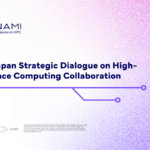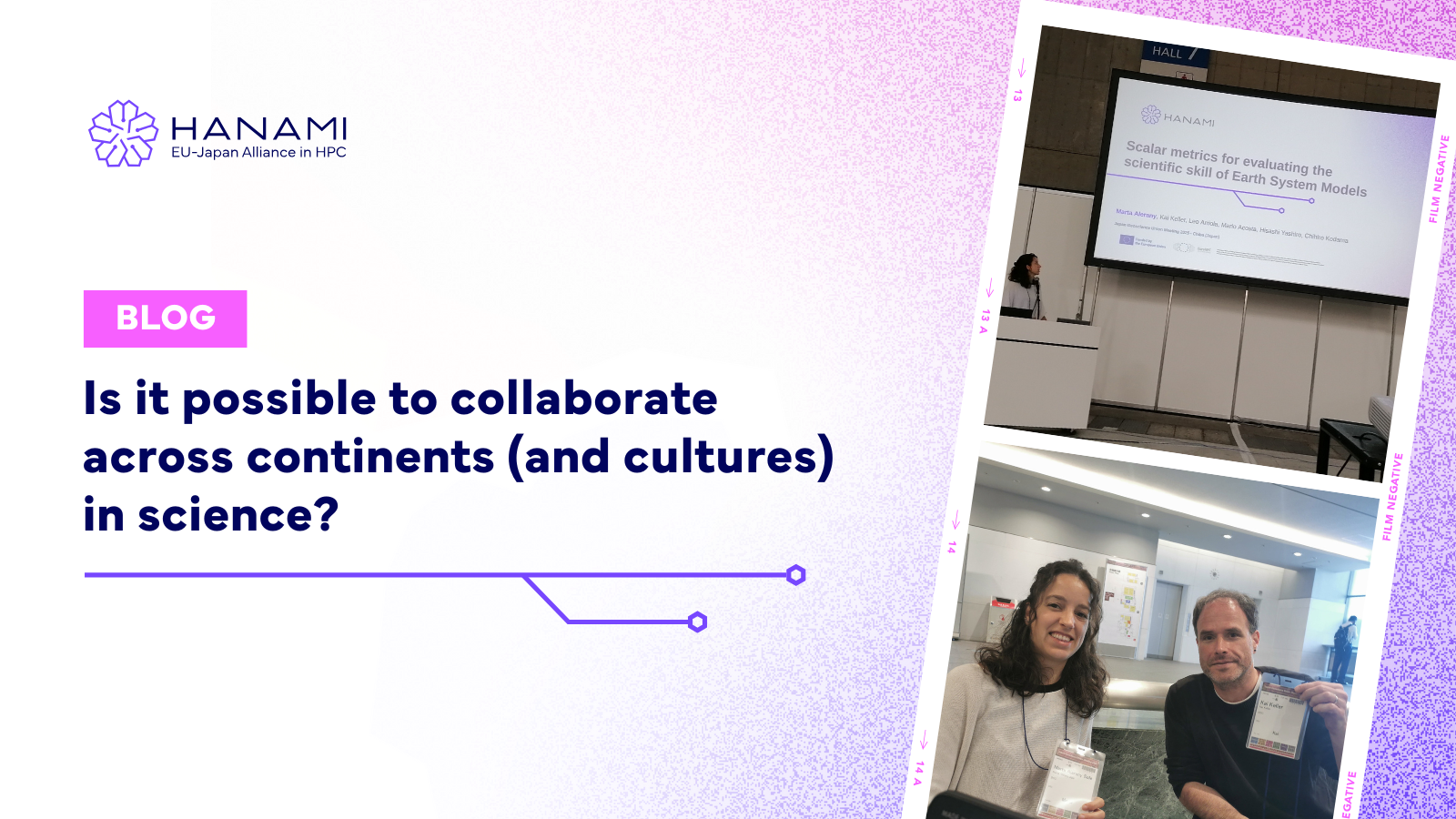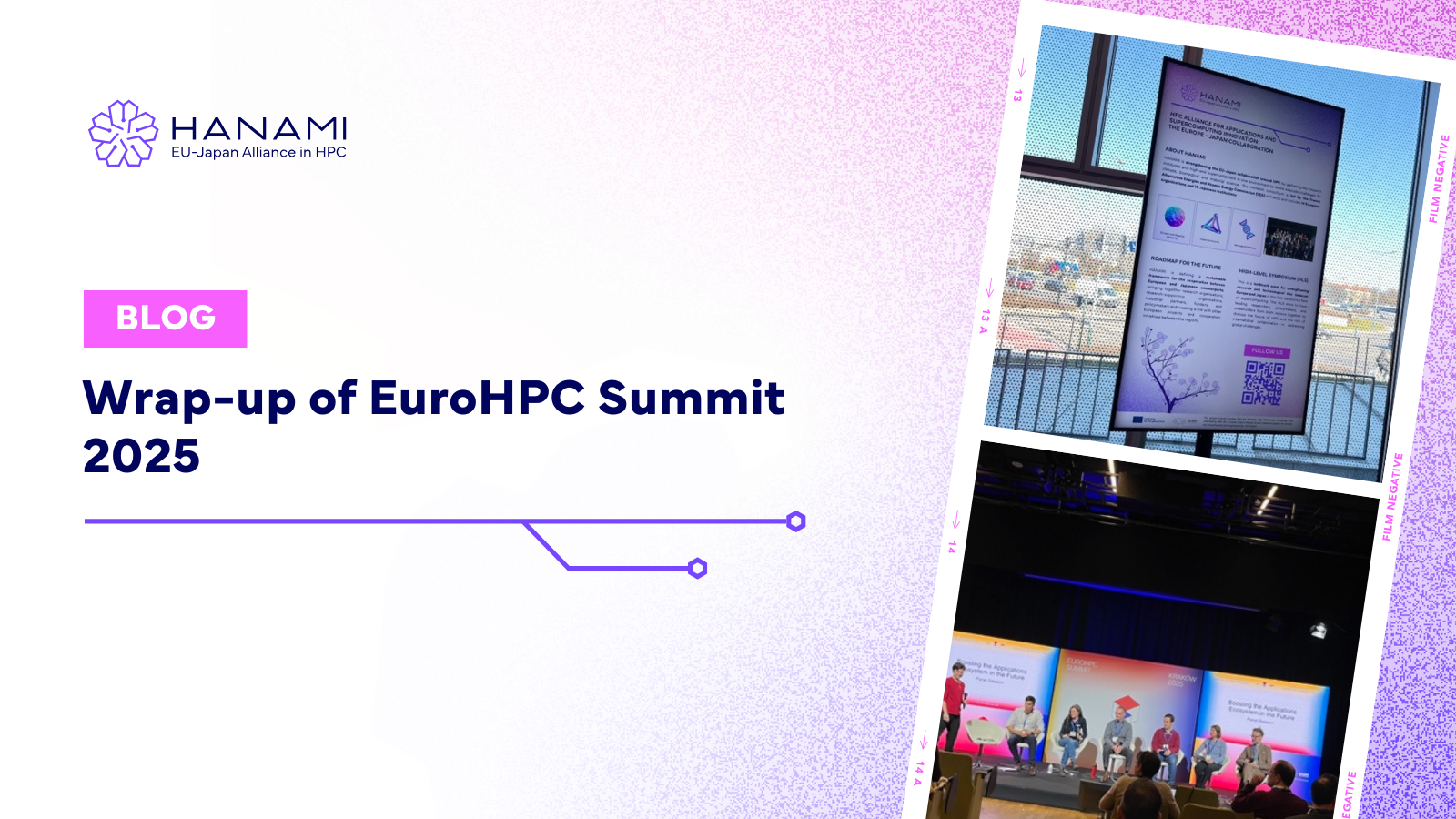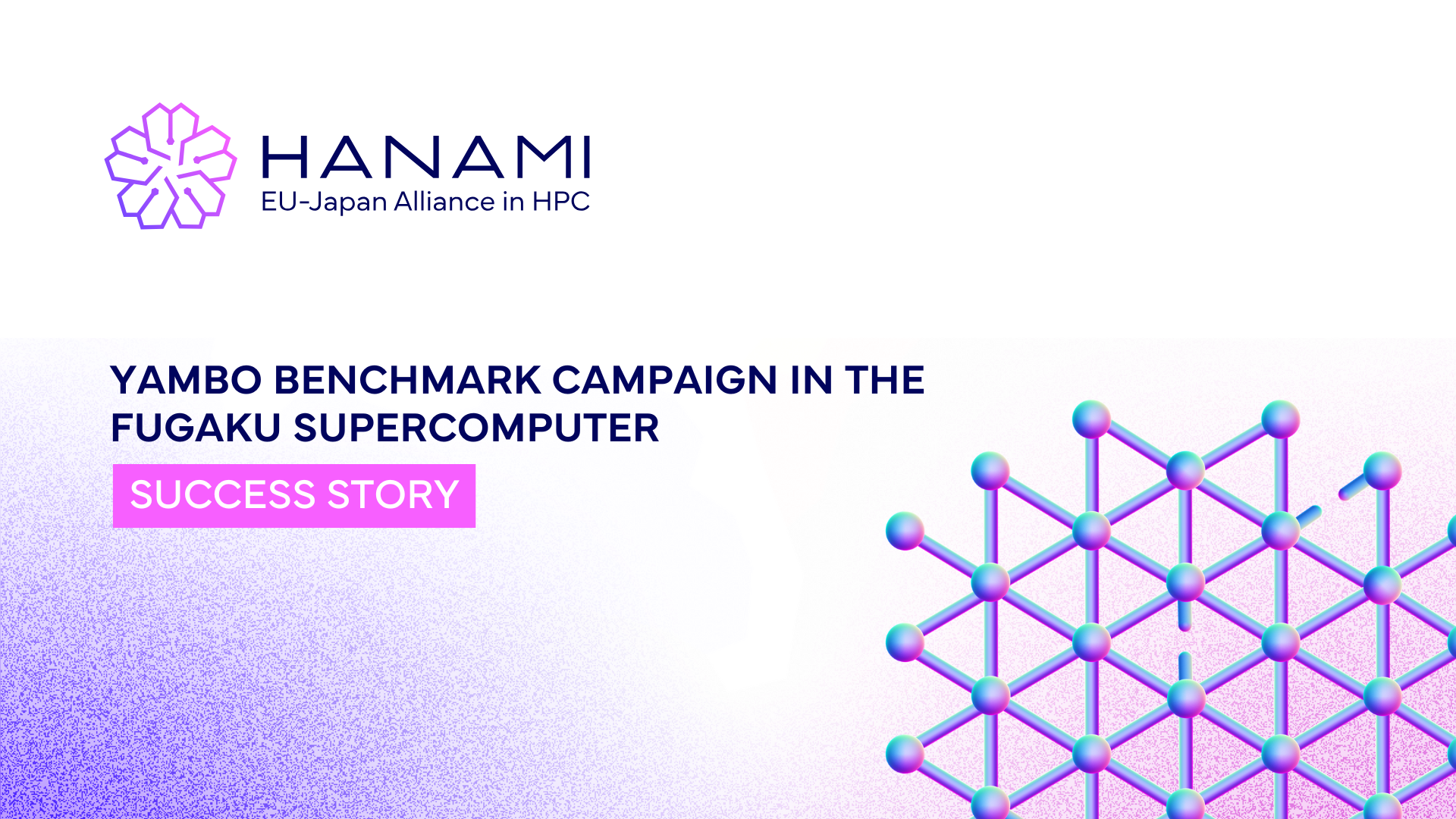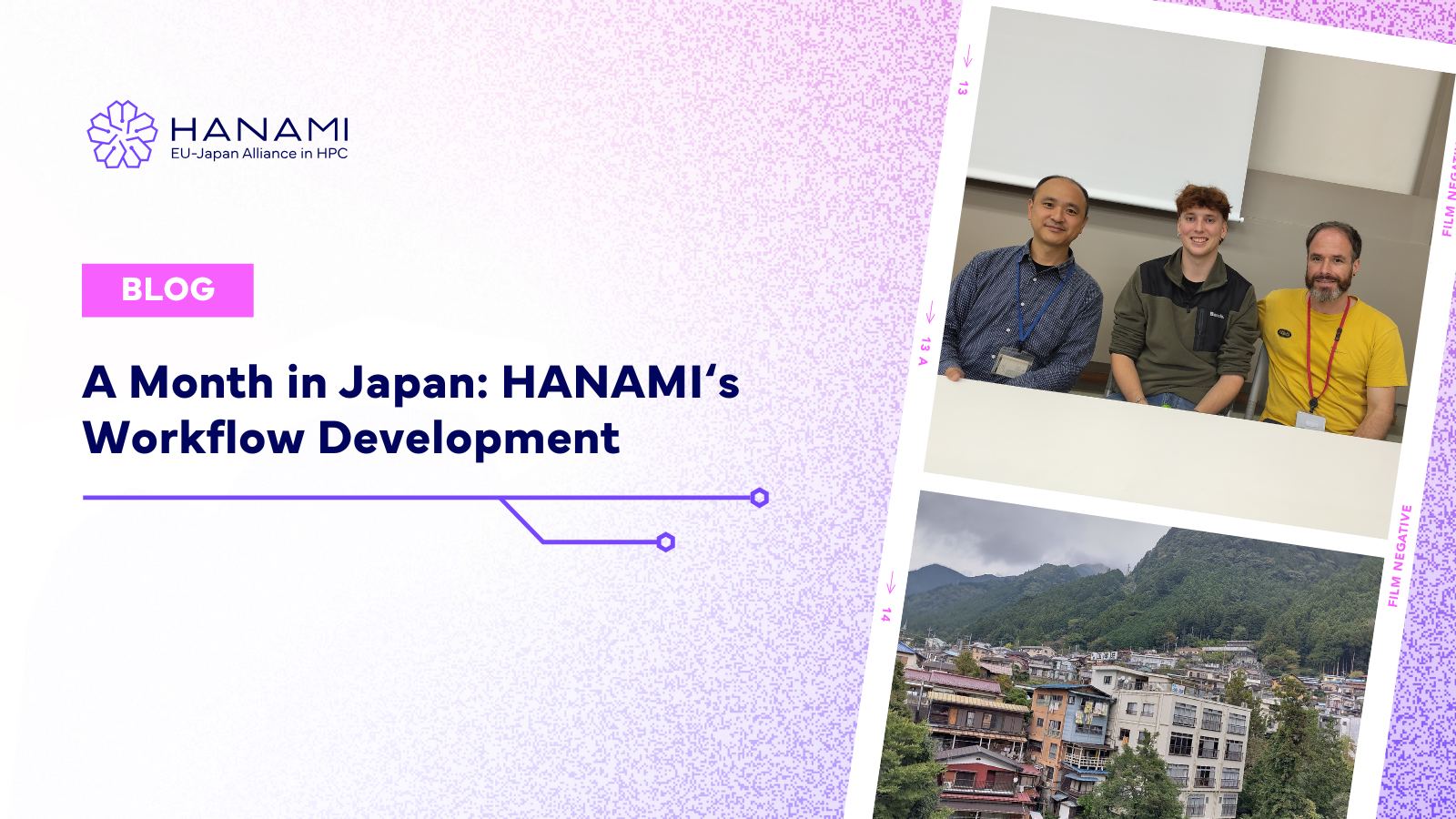Blog
06/02/2025
Strengthening EU-Japan Partnerships: Key Outcomes from the First HANAMI Symposium
By the Barcelona Supercomputing Center (BSC)
The first HANAMI High-Level Symposium successfully advanced its primary goal of fostering scientific and technological collaboration between European and Japanese researchers. Participation statistics from the symposium reflected strong engagement from both European and Japanese researchers, with 22% of the 90 attendees from Japan. This active involvement underscores the effectiveness of HANAMI’s networking and community-building strategies.
As the main outcome of the symposium, the consortium would like to highlight the strengthening of the collaboration projects within the three scientific WPs. The parallel tracks were instrumental in identifying common interests and issues, fostering discussions and reaching agreements to improve the HANAMI projects’ development moving forward. The three topical tracks within the first HANAMI High-Level Symposium were packed with presentations and discussions that contribute to the ongoing scientific collaborations between European and Japanese organisations.
Climate Modelling
The scientific track organised by WP4 began with Mario Acosta introducing the session and the ongoing collaborations and plans within HANAMI for WP4. Then, Kai Keller discussed Earth system model workflow interfaces, while Joachim Biercamp covered high-performance climate and weather benchmarks. Piotr Dziekan presented on LES (Large Eddy Simulation) modelling, exploring advances in this area. After a break, the focus shifted to ocean and atmospheric modelling, with Miguel Andrés-Martínez delving into the HPC aspects of the FESOM ocean model, and Stella Paronuzzi providing insights into the HPC perspective within the EDITO project. The second day included a wide range of technical discussions, beginning with Shin-ichiro Shima and Hisashi Yashiro exploring advances in atmospheric modelling with NICAM and Fugaku. Leo Arriola and Miguel Castrillo presented automation and reproducibility workflows for NICOCO using Autosubmit. Later, David Guibert conducted sessions on HPCW workshops, followed by internal WP4 discussions on the current project status and plans. After the lunch break, the focus turned to replicability in Earth system models presented by Marta Alerany, and the application of machine learning for reconstructing historical land surface boundary conditions by Amirpasha Mozaffari. The day concluded with a wrap-up session summarizing insights and outcomes.
Biomedical Applications
In this parallel track, WP5 coordinators conducted a session dedicated to the mathematical modelling of biological problems across multiple scales, ranging from cellular dynamics to molecular interactions between proteins. This session involved Japanese partners and some invited international speakers, including Anna Niarakis and Roman Bauer. These discussions were pivotal for advancing the technical objectives outlined in the WP5, leveraging the expertise of our collaborators.
The session began with a presentation on benchmarking multiscale tools for simulating cell populations. This initiative, designed as a collaborative effort among tool developers, is expected to have a significant impact in the mid-term, helping the research community to share and design new standards to improve the interoperability and reproducibility of tested computational frameworks. Given the high computational demands of these tools, a key project goal is their optimization for deployment on European supercomputers like MareNostrum5, as well as Japanese systems such as Fugaku. We then explored integrating diverse molecular pathway models, including metabolic and signalling pathways represented by Boolean networks, into cellular simulations. Discussions emphasized the computational challenges posed by these modelling approaches and examined strategies for optimizing code and scaling them to tackle more realistic scenarios in biomedicine.
Finally, WP5 Japanese collaborators, Ai Shinobu and Elisa Dominguez from the PRIME Institute in Osaka, presented the strengths and limitations of molecular dynamics techniques. These computational simulation methods, traditionally used in biology to analyze the physical movements of atoms and molecules, offer valuable insights into protein networks from both experimental and computational perspectives. This approach will allow us to quantify the effects of critical mutations in cancer observed in protein sequences and assess their influence on cellular behaviour and tissue architecture. This strategic collaboration fosters synergy between the main objectives of Projects 1 and 2 within WP5, also promoting deeper integration between European and Japanese efforts. Given the significant computational requirements, optimizing these tools for current supercomputers in both regions will be a priority, evaluating how accelerators such as GPUs could help to tackle more complex use cases. Additionally, it sets the stage for co-developing between European and Japanese advanced computational tools to address the described goals, which is one of the main objectives of HANAMI.
Material Science
On Monday, January 13th, the WP6 Materials Science track explored the role of high-performance computing in accelerating discovery through advanced computational tools and libraries. The session began with an overview of the SIESTA code by A. Garcia, highlighting its features and performance in materials modelling. M. Casula discussed optimizing wave functions in quantum Monte Carlo simulations, followed by K. Nakano, who introduced a new force calculation method integrated with machine-learning potential. D. Varsano presented the Yambo code, emphasizing its performance and applications in materials science. After the break, A. Pecchia introduced the libNEGF library, designed for non-equilibrium Green’s function calculations. L. Genovese showcased a case study on HIV-1 drug resistance using interoperable workflows on heterogeneous supercomputers, and X. Wu detailed advancements in the ChASE eigensolver on GPUs, with a final demonstration by C. Richefort integrating ChASE into the Yambo code for enhanced functionality.
On Tuesday, January 14th, the sessions began with a focus on numerical techniques and their future in materials science, with T. Imamura exploring next-generation eigenvalue solvers and W. Dawson discussing methods to reduce precision requirements in electronic structure calculations. Later, the focus shifted to energy materials, where E. Artacho examined radiation damage in nuclear materials through first-principles simulations, and R. Rurali outlined the pathway from ferroelectrics to photophononics. M. Otani and P. Ordejon presented hybrid approaches for modelling electrochemical interfaces, while N. Wittemeier highlighted upcoming features in SIESTA for simulating advanced materials. G. Giorgi concluded the morning by exploring the electronic and optical properties of lead-free halide perovskites. The afternoon delved into specialized material studies, including K. Yamashita’s work on defects in perovskites, C. Borghesi’s analysis of charge transfer mechanisms in luminescent materials, A. Raghav’s investigation into the superconducting properties of lanthanum hydride, and M. Cherubini’s detailed examination of sulfur hydride’s phase diagram and anharmonic phonons.
The symposium’s hybrid format allowed for broad participation, while the co-located activities, including the CEA-RIKEN school and HANAMI Steering Board meetings, further enriched the event’s impact. The involvement of high-profile keynote speakers from both Europe and Japan added prestige and depth to the discussions, while the dissemination of event highlights through various media channels amplified the symposium’s visibility.
In conclusion, the first HANAMI symposium not only reinforced existing partnerships but also laid the groundwork for new collaborations that promise to drive innovation across HPC and AI applications, ensuring the sustainability and growth of EU-Japan scientific cooperation. Fabrizio Gagliardi (Barcelona Supercomputing Center) in charge of organising the HANAMI Symposium, concluded that “the HANAMI symposium has confirmed the importance of scientists meeting together in person for an extended time. Several lines of activity were brought together in a more synergistic approach. A stronger feeling of belonging to an international-focused group to achieve common goals was achieved. For me, this is probably the most noticeable accomplishment of the symposium”.

